集体教案基英综合英语2 unit1
- 格式:doc
- 大小:197.00 KB
- 文档页数:25
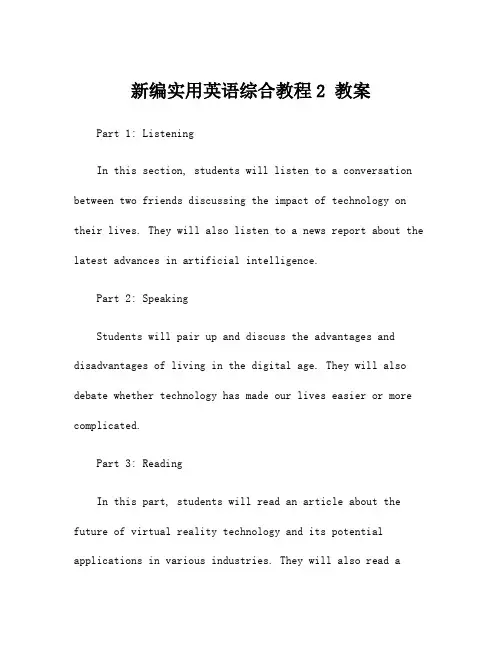
新编实用英语综合教程2 教案Part 1: ListeningIn this section, students will listen to a conversation between two friends discussing the impact of technology on their lives. They will also listen to a news report about the latest advances in artificial intelligence.Part 2: SpeakingStudents will pair up and discuss the advantages and disadvantages of living in the digital age. They will also debate whether technology has made our lives easier or more complicated.Part 3: ReadingIn this part, students will read an article about the future of virtual reality technology and its potential applications in various industries. They will also read ashort story about a robot that learns to think and feel like a human.Part 4: WritingStudents will practice writing a persuasive essay on the topic "Is technology making us smarter or lazier?" They will need to provide evidence and examples to support their argument.Unit 2 Social MediaPart 1: ListeningStudents will listen to a podcast about the impact of social media on mental health and relationships. They will also listen to a discussion about the pros and cons of using social media for activism.Part 2: SpeakingIn this section, students will participate in a group discussion on the topic "Should social media platforms beregulated?" They will need to express their opinions and listen to their classmates' viewpoints.Part 3: ReadingStudents will read an article about the rise ofinfluencer marketing on social media platforms. They will also read a blog post about the benefits of using social media for networking and career advancement.Part 4: WritingIn the writing task for this unit, students will create a social media campaign for a fictional company. They will need to come up with a creative strategy to promote the company's products or services on different social media platforms.Unit 3 Online SecurityPart 1: ListeningStudents will listen to a cybersecurity expert discussing common online security threats and how to protect againstthem. They will also listen to a news report about a recent data breach at a major company.Part 2: SpeakingIn this section, students will participate in role-plays where they act out different online security scenarios. They will need to practice giving advice on how to stay safe online and protect personal information.Part 3: ReadingStudents will read an article about the importance of using strong passwords and two-factor authentication to secure online accounts. They will also read a case study about a social engineering attack that led to a data breach.Part 4: WritingFor the writing task in this unit, students will compose an email to a friend explaining the importance of online security measures. They will need to provide tips andrecommendations for staying safe online and avoiding common scams and phishing attempts.。
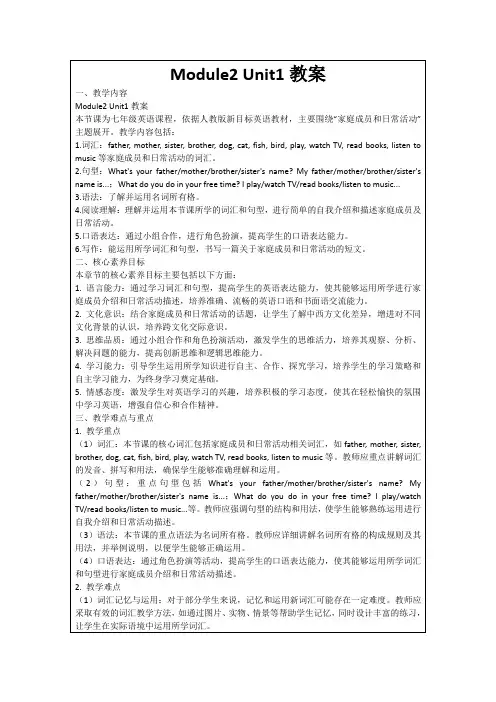
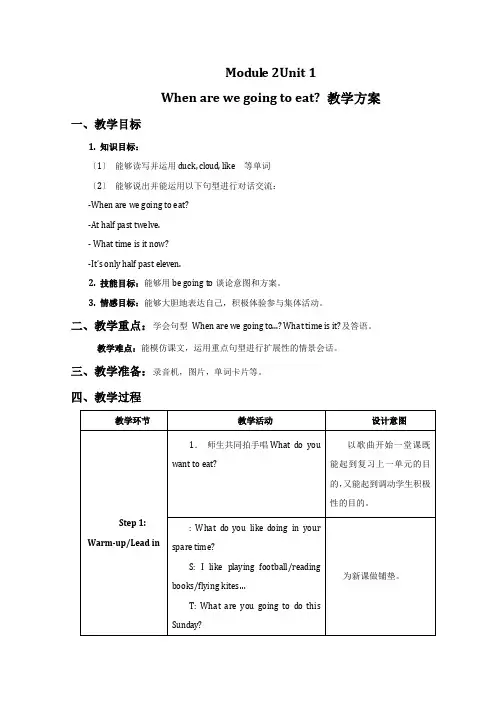
Module 2Unit 1When are we going to eat? 教学方案一、教学目标1. 知识目标:〔1〕能够读写并运用duck, cl oud, like 等单词〔2〕能够说出并能运用以下句型进行对话交流:-When are we going to eat?-At half past twelve.- What time is it now?-It’s only half past eleven.2. 技能目标:能够用be going to谈论意图和方案。
3. 情感目标:能够大胆地表达自己,积极体验参与集体活动。
二、教学重点:学会句型When are we going to...? What time is it?及答语。
教学难点:能模仿课文,运用重点句型进行扩展性的情景会话。
三、教学准备:录音机,图片,单词卡片等。
四、教学过程五、板书设计Modul e 2 Unit 1When are we going to eat?duck these ducks -When are we going to eat?cloud dark clouds -At half past twelve.like look like - What time is it now?-It’s only half past eleven.六、教学反思各教学环节紧扣,设计突出学生的认知特点,认知规律。
用直观形象的幻灯片学习新知激发学生的学习兴趣,用游戏不但稳固了本课的知识更活泼了课堂气氛,做到了英语学习兴趣的持久性。
从多侧面表达多媒体的作用。
紧紧抓住重难点,层层击破。
本节课的板书明了清晰,学生很容易把握住本课的知识点。
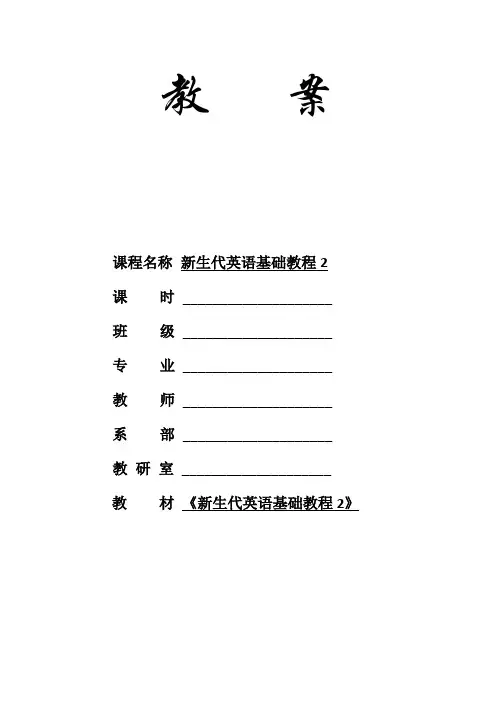
教案课程名称新生代英语基础教程2课时____________________班级____________________专业____________________教师____________________系部____________________教研室____________________教材《新生代英语基础教程2》FamilyShow Time“Where are you from”ReadingWhy is it called a honeymoonChat TimeThe rest is history.WritingFamily treeGrammarThe possessive ’sMy StoryFamilyHave students look at the picture and askthem to tell you as much as they canabout it.Then, go through the questions andcomplete each answer. In addition, youcan ask a few warm-up questions such as“How many people are in your family”Have the students listen and repeat the words. Use descriptive sentences to teach the family member words. For example, you can say “Your uncle is your mother or father’s brother.” “Your aunt is your mother or father’s sister.” “Your cousin is your uncle or aunt’s child,” and so on. A simple family drawn on the board can often help students to understand this.They may find it interesting to see your family tree, if you don’t min d sharing it with them.For the word frame, you can see that it is something we put around important pictures. You can then ask students if they have any framed photos in the class. You can also teach that we use the words married and single to describe s omeone’s relationship status. Ask “Have you been to a wedding recently” “Who got married”For Tell the students they will hear a conversation between a radio host and a celebrity (Anna). Now listen to the conversation and have students complete the sentences.Correct any mistakes. Have students talk about family members with sentencesthey have learnt.For Exercise D, let students match those Chinese kinship terms to the corresponding English definitions.First, have the students watch the video in its entirety. Ask basic comprehension questions such as, “Who are the main characters in this video” “Where are they” “What are they doing” “Why are they doing that” “How are they doing it”Next, have students take turns in explaining what is happening in each picture.Watch the video. Now look at Exercise B, and ask students to complete the True / False statements.Next, students can complete the dialogue in Exercise C. Have three students read out the dialogue with one student playing the role of Naomi, one as Hector and the other as Mrs. Sanchez. For an extension activity, you can also have the students redo the conversation using information from their family. Finally, have students match the questions to the answers in Exercise D.Review the vocabulary word honeymoon. Ask them to give you examples of where people might go on their honeymoon. Some students may even know where their parents went on honeymoon.Next, read and listen to the text and have the students read each of the True / False statements and choose the correctPut the students in pairs and have them practice talking about where they would like to go on honeymoon. Every two minutes have students stand up and change partners. Do this three or four times, depending on class size.Ask students to draw a poster and fill in some information. Ask students to introduce and advertise their dream honeymoon package to all classmates.Explain to students that they will hear a conversation in which Andrew tells Jenny about his wedding plans. Introduce the key vocabulary words for this conversation.Tell the students to listen carefully and write down what they hear in the blank spaces. If necessary, pause the recording so that students have time to write.Next, have students practice asking about families in pairs, monitoring them while they do so.Now, have students read through the Language Note, teaching the phrase “the rest is history.”For Exercise C, you can divide students into pairs, and ask them to act out the situation. They can take turns playingAsk students to look at the family tree and fill in the names and their occupations. Check their work.Ask students to write names and occupations of their family members as in the example. Remind them of the appropriate form of Chinese names. Have two volunteers write their answers on the board and check their spelling.Teach students to describe their family relations using the sentence pattern in Exercise C.Explain to students that we use the possessive s to describe who owns something. First, write a large ’s on the board. Next, tell the students that we add ’s for when one person owns something. Walk around the class, picking up students’ items and giving examples, such as “This is John’s book”, emphasizing the ’s. Have students echo you and then ask them to try on their own.Then, tell students that for two names, we add ’s to the second name only.After that, you will need to tell students about irregular plurals. Make examples using the most common irregular plurals used with ’s: children, men, women and people, etc.Let students complete the exercises, and then ask them to change books and go through the answers, correcting any mistakes.My Story To improvestudents’ listeningcomprehensionand speakingability through theuse of videoTell students that they will see a video in whichreal people talk about their families.Now, watch the video and have students completethe true or false statements. In some cases, youmay need to pause the video to help the students.Now, have students tell you the answers,correcting any mistakes. Watch the video againand have students write in the missing words,pausing the video if necessary. Check thestudents’ answers, correcting any mistakes.For the discussion section, start by going throughthe model answers in the book, and have studentsrepeat after you. Then, give the students youranswers to the questions. Next, you can haveseveral students give their answers to the class.Finally, have the students discuss the questions inpairs and/or in groups.课后学习设计作业Finish all the exercises in Unit 1.Read the text in this unit again and try tosummarise its content.Interview a family member and write a familydescription for him/her.课后总结与反思补充教学资源VOCABULARY BUILDER参考译文主持人:您正在收听的是诺维奇广播电台,我是主持人艾伦·彼得斯。
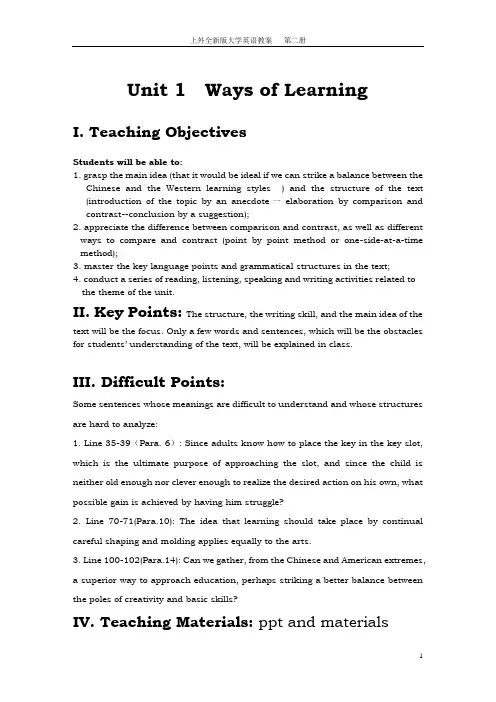
Unit 1 Ways of LearningI. Teaching ObjectivesStudents will be able to:1. grasp the main idea (that it would be ideal if we can strike a balance between theChinese and the Western learning styles ) and the structure of the text (introduction of the topic by an anecdote一elaboration by comparison and contrast--conclusion by a suggestion);2. appreciate the difference between comparison and contrast, as well as different ways to compare and contrast (point by point method or one-side-at-a-time method);3. master the key language points and grammatical structures in the text;4. conduct a series of reading, listening, speaking and writing activities related to the theme of the unit.II. Key Points: The structure, the writing skill, and the main idea of thetext will be the focus. Only a few words and sentences, which will be the obstacles for students’ understanding of the text, will be explained in class.III. Difficult Points:Some sentences whose meanings are difficult to understand and whose structuresare hard to analyze:1. Line 35-39(Para. 6): Since adults know how to place the key in the key slot,which is the ultimate purpose of approaching the slot, and since the child isneither old enough nor clever enough to realize the desired action on his own, whatpossible gain is achieved by having him struggle?2. Line 70-71(Para.10): The idea that learning should take place by continualcareful shaping and molding applies equally to the arts.3. Line 100-102(Para.14): Can we gather, from the Chinese and American extremes,a superior way to approach education, perhaps striking a better balance betweenthe poles of creativity and basic skills?IV. Teaching Materials: ppt and materialsV. Teaching Methods: Lecturing, practicing and discussing.VI. Teaching Timing: 8 sessions of classVII. Teaching Process:1st -2nd periods:Pre-reading; Teacher’s Introductory Remarks and Students’ Discussion related to the topic.3rd -4th periods: While-Reading (Understanding the title of text A; Analyzing the organization of the text; Explaining Difficult sentences and language points in the text; Summing up the main idea of the text)5th-6th periods: Dealing with the exercises after Text A. Check on Ss’ home reading (Text B); Post-Reading Task: Theme-Related Language Learning Tasks7th-8th periods: Listening and speaking tasks.A. Pre-reading tasksPre-reading tasks1.T asks Ss the following questions. The first is based on the song. Teach YourChildren: (5minutes )According to the song, who should teach whom? Is learning a one-way street?(Parents and children should teach each other and learn from each other. Learning is a two-way interaction.)Can you guess what the theme of this unit, ways of learning, refers to? (Different people have different learning styles)2. Ss listen to the fo11owing quotation from《文汇读书周报》(2001年12月1日第一版,"自主教育:“管”还是“不管”?) take some notes and then T will invite some Ss to summarize in English how Chen Yu hua’s parents handle her education.一本由中国经济出版社推出的《千万别管孩子一一自主教育哈佛启示录》的书近来极为畅销,问世才一月,在全国销售量已达到20余万册。
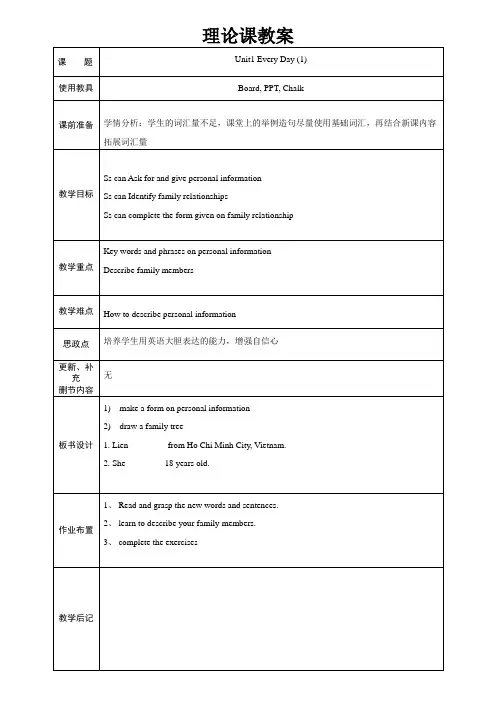
理论课教案主要教学内容及步骤教师活动学生活动Lesson1 Where are you from?Step 1 Warming-upWork in pairs. Talk about the city you from,ages and other personal information then make a presentation in front of the class.Step 2 Presentation(1)PPT Display:Read the chartFill in the blanks according to chart1. Kenji is from ___________________.2. Anya is from ___________________.3. Gilberto _______________________.2)Lead-in:Read the words in the box and complete the table.25 years old divorced single city married state country old youngWork in pairs. Ask and answer questions about the students belowEXAMPLE:Student A: Where is Kenji from? Student B: He is from Japan.Student A: How old is he? Student B: He is 22 years old. Student A: Is he married? Student B: No, he is single. 1、与搭档讨论你来自哪里,年龄多大,以及个人的生活状态。
用用英语进行交流对话并上台展示。
2.教师针对学生的分享作点评和记录,主要以表扬为主,尤其是语法语句正确的。
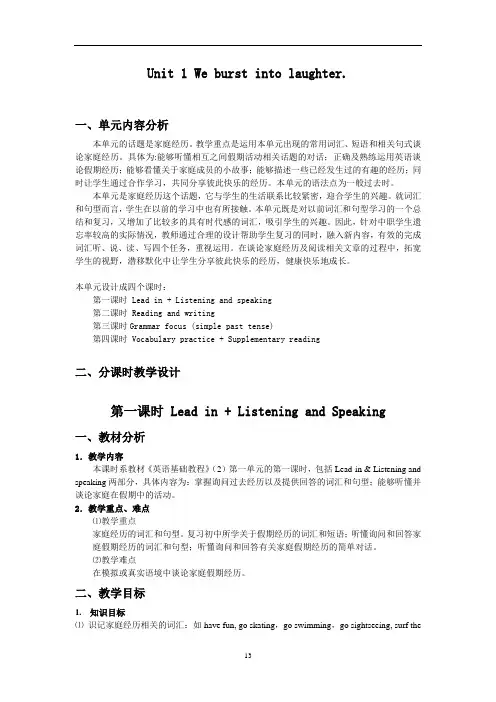
Unit 1 We burst into laughter.一、单元内容分析本单元的话题是家庭经历。
教学重点是运用本单元出现的常用词汇、短语和相关句式谈论家庭经历。
具体为:能够听懂相互之间假期活动相关话题的对话;正确及熟练运用英语谈论假期经历;能够看懂关于家庭成员的小故事;能够描述一些已经发生过的有趣的经历;同时让学生通过合作学习,共同分享彼此快乐的经历。
本单元的语法点为一般过去时。
本单元是家庭经历这个话题,它与学生的生活联系比较紧密,迎合学生的兴趣。
就词汇和句型而言,学生在以前的学习中也有所接触。
本单元既是对以前词汇和句型学习的一个总结和复习,又增加了比较多的具有时代感的词汇,吸引学生的兴趣。
因此,针对中职学生遗忘率较高的实际情况,教师通过合理的设计帮助学生复习的同时,融入新内容,有效的完成词汇听、说、读、写四个任务,重视运用。
在谈论家庭经历及阅读相关文章的过程中,拓宽学生的视野,潜移默化中让学生分享彼此快乐的经历,健康快乐地成长。
本单元设计成四个课时:第一课时 Lead in + Listening and speaking第二课时 Reading and writing第三课时Grammar focus (simple past tense)第四课时 Vocabulary practice + Supplementary reading二、分课时教学设计第一课时 Lead in + Listening and Speaking一、教材分析1.教学内容本课时系教材《英语基础教程》(2)第一单元的第一课时,包括Lead-in & Listening and speaking两部分,具体内容为:掌握询问过去经历以及提供回答的词汇和句型;能够听懂并谈论家庭在假期中的活动。
2.教学重点、难点⑴教学重点家庭经历的词汇和句型。
复习初中所学关于假期经历的词汇和短语;听懂询问和回答家庭假期经历的词汇和句型;听懂询问和回答有关家庭假期经历的简单对话。
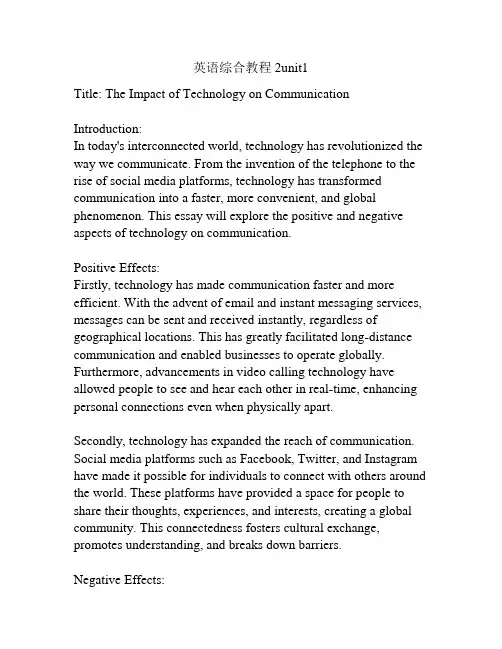
英语综合教程2unit1Title: The Impact of Technology on Communication Introduction:In today's interconnected world, technology has revolutionized the way we communicate. From the invention of the telephone to the rise of social media platforms, technology has transformed communication into a faster, more convenient, and global phenomenon. This essay will explore the positive and negative aspects of technology on communication.Positive Effects:Firstly, technology has made communication faster and more efficient. With the advent of email and instant messaging services, messages can be sent and received instantly, regardless of geographical locations. This has greatly facilitated long-distance communication and enabled businesses to operate globally. Furthermore, advancements in video calling technology have allowed people to see and hear each other in real-time, enhancing personal connections even when physically apart.Secondly, technology has expanded the reach of communication. Social media platforms such as Facebook, Twitter, and Instagram have made it possible for individuals to connect with others around the world. These platforms have provided a space for people to share their thoughts, experiences, and interests, creating a global community. This connectedness fosters cultural exchange, promotes understanding, and breaks down barriers.Negative Effects:However, the excess use of technology can have detrimental effects on communication. Face-to-face interactions are becoming increasingly rare, as individuals are consumed by electronic devices. This leads to a decline in interpersonal skills and the ability to effectively communicate non-verbally. Excessive reliance on technology may also create a sense of detachment and isolation, as real-time human contact is replaced by virtual interactions.Moreover, technology has opened the doors to cyberbullying and online harassment. The anonymity provided by online platforms can embolden individuals to engage in harmful behavior, causing emotional distress and damaging relationships. The constant exposure to a vast amount of information and opinions on the internet can also lead to information overload and a breakdown in critical thinking skills.Conclusion:In conclusion, technology has undoubtedly revolutionized communication, offering numerous benefits such as increased efficiency and global connectivity. However, it is essential to strike a balance between the use of technology and maintaining genuine human connections. By being aware of the potential negative effects and managing technology use responsibly, we can harness its power to enhance communication while preserving meaningful interpersonal relationships.。
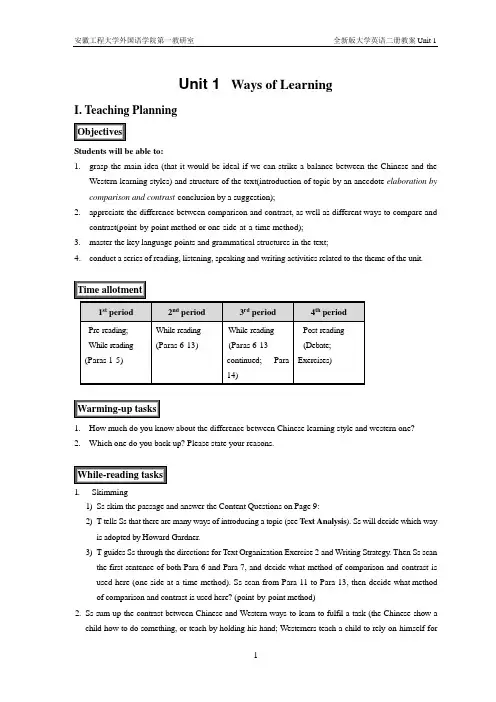
Unit 1Ways of LearningI. Teaching PlanningStudents will be able to:1.grasp the main idea (that it would be ideal if we can strike a balance between the Chinese and theWestern learning styles) and structure of the text(introduction of topic by an anecdote elaboration by comparison and contrast-conclusion by a suggestion);2.appreciate the difference between comparison and contrast, as well as different ways to compare andcontrast(point-by-point method or one-side-at-a-time method);3.master the key language points and grammatical structures in the text;4.conduct a series of reading, listening, speaking and writing activities related to the theme of the unit.1. How much do you know about the difference between Chinese learning style and western one?2. Which one do you back up? Please state your reasons.1. Skimming1) Ss skim the passage and answer the Content Questions on Page 9:2)T tells Ss that there are many ways of introducing a topic (see T ext Analysis).Ss will decide which wayis adopted by Howard Gardner.3)T guides Ss through the directions for Text Organization Exercise 2 and Writing Strategy. Then Ss scanthe first sentence of both Para 6 and Para 7, and decide what method of comparison and contrast is used here (one-side-at-a-time method). Ss scan from Para 11 to Para 13, then decide what method of comparison and contrast is used here? (point-by-point method)2.Ss sum up the contrast between Chinese and Western ways to learn to fulfil a task (the Chinese show achild how to do something, or teach by holding his hand; Westerners teach a child to rely on himself forsolutions to problems).3.Ss sum up the contrast between the Chinese and the Western attitudes toward creativity and basic skills.(The Chinese give priority to developing skills at an early age, believing that creativity can be promoted over time; Westerners put more emphasis on fostering creativity in young children, thinking that skills can be picked up later.)4.T tells Ss that there are many ways of concluding an essay (see Text Analysis).Ss decide whichway is used in this essay.5.T explains language points and gives Ss practice (see Language Study).1. Debate: Should we develop children’s creativity first or train them in basic skills first?1)Ss divide into two groups, one taking the side of creativity first, another taking the side of basicskills first.2)In each group, Ss further divide into smaller groups of three to four, brainstormingarguments \ examples \ statistics \ quotes \ etc. in support of their viewpoint, as well as those that could be used to refute the other side.3)Debate begins, with T acting as moderator.2.T guides Ss through several after-text exercises.3.T checks on Ss’ home reading (Text B).4.Ss do Part IV: Theme-Related Language Learning Tasks. (1 period)5.T asks Ss to prepare the next unit:1)do the pre-reading task;2)preview Text A.Ⅱ. Text AnalysisAn essay is usually made up of three parts: a beginning where the topic is introduced; the body part where the topic is elaborated on, and a conclusion.Besides stating the topic directly, there are many other ways to introduce a theme. In this text, an anecdote or an incident is used. The author of Text A, Unit 6, Book 1 (What Animals Really Think) introduces his topic by posing a question: “Do animals all have thoughts, what we call con sciousness?” Text B, Unit 3, Book 1 (How to Make Sense out of Science) begins by quoting newspaper headlines:“New Drugs Kill CancerDevastation by El Nino — a Warning6:30 p.m. October 26, 2028: Could This Be the Deadline for the Apocalypse?”Text B of this unit, Children and Money, begins with an imagined argument between a child and his parent over the control of pocket money. Discover other forms of introduction as you read on. However, the more important point is that you should learn to vary your own writing by adopting various types of topicintroduction.Without a conclusion, an essay lacks a sense of completeness. A conclusion may be a restatement of the main points previously mentioned, a proposed solution, a quotation from some book or person, a prediction of future developments, a suggestion for further study, etc. Text B, Unit 3, Book 1 ends by giving a simile, comparing scientific research to mountain climbing, “a process filled with disappointments and reverses, but somehow we keep moving ahead.” In this text, Howard Gardner makes a suggestion in the form of a question.Ⅲ. Cultural Notes1. Education in the West: There is no common agreement in the West concerning the best method of education. A variety of views can be found among parents, teachers and students. Indeed, it might be argued that it is this very existence of contending points of view that is characteristic of Western education. This can be seen as far back as in the work of the ancient Greek philosopher Socrates, who encouraged his students to question everything, even their most fundamental beliefs. Y et even then there was no general agreement that this was the best way to teach. Socrates, after all, was condemned to death by his fellow citizens for corrupting the morals of the young by his way of teaching. Many later periods of Western history were no more tolerant of encouraging students to challenge traditional beliefs: Darwin’s theory of evolution, for example, was for a time banned from schools in some American states on the grounds of religious belief.Much of the current debate over education surrounds the extent to which learning should be teacher-based or student-based. Which of the two should decide what should be learned, how it should be learned, and when it should be learned? Comparing Western and Asian methods of learning it is generally true that Western methods are more student-centred, expecting students to discover things for themselves rather than relying on their teachers to tell them. An extreme version of the student-centred approach can be seen at Summerhill, a school in England established by the educationalist A.S. Neill.There children have complete freedom to decide what they are going to learn and which lessons they will attend. If they wish they need not attend any at all. Mainstream education in England is far more strict, demanding that children attend lessons and follow a national curriculum. This curriculum and the importance of achieving good exam results tend to reinforce a more teacher-centred approach, as both teachers and students find the pressure of time leaves less opportunity for an exploratory approach to learning.The extent to which learning is teacher-centred or student-centred also depends on differences between subjects. In recent years, for example, there has been a trend in the teaching of mathematics in school classrooms in England away from having pupils work on their own or in small groups back towards a more traditional approach, with the teacher guiding the entire class step-by-step through a lesson. This followed research that suggested that, as far as maths was concerned, a more teacher-centred method was more effective.2. Standing on the shoulders of giants: a well-known phrase, frequently employed by inventors toexpress modesty about their achievements. The suggestion is that while they have been able to see further than those who came before them, it is not because they themselves are intellectual giants. Rather it is because they have been able to build upon the accumulated discoveries of their great predecessors.Ⅳ. Language Study1.attach: fasten or join (one thing to another) (used in the pattern: attach sth. to sth.)Examples: Attached to this letter you will find a copy of the document you asked for.2.... to position the key just so: to position the key carefully to fit into the narrow key slot3.not in the least: not at allExamples: I am not in the least touched by the Marilyn Monroe kind of beauty.Ann didn’t seem in the least concerned about her study.4. find one’s way: reach a destination naturally; arrive atExamples: Shanghai is not an easy city to find your way around.Drunk as he was, Peter still found his way home.5. phenomenon: (pi. phenomena) sth. that happens or exists and that can be seen or experiencedExamples: Hurricanes are a relatively common phenomenon in the Caribbean.Stress-related illness is a common phenomenon in big cities. Thunder and lightening arenatural phenomena.6. initial: of or at the beginning, first (adj., used only before n.)Examples: If a car suddenly pulls out in front of you, your initial reaction may include fear and anger.Their initial burst of enthusiasm died down when they realized how much work the jobinvolved.7. assist: help (used in the pattern: assist sb. to do sth., assist sb. with sth.)Examples: The professor was assisting his students to prepare their project.The college student decided to assist the boy with his study.8. insert: put, fit, place (in, into, between)Examples: Wait for a couple of minutes with your mouth closed before inserting the thermometer.The doctor carefully inserted the needle into my left arm.9. somewhat: to some degree, a littleExamples: It is reported that conditions in the village have improved somewhat since November.--- “Are you concerned about your exam results?”--- “Somewhat.”10. await: (finl) wait forAwait is a fairly common word in formal writing, but you do not usually use it in conversation.Instead you use “wait for.”Examples: We must await the results of field studies yet to come.After I sent the letter asking for a job, I had nothing to do but await the answer.11. on occasion: now and thenExamples: I was usually the only foreign participant, although on occasion I brought other Americans in as guests.Steve spent almost all his time doing his research, but, on occasion, he would take his sonto see a film.12. neglect: give too little attention or care toExamples: He gave too much attention to his career, working long hours and neglecting his wife.Their investment turned out to be a failure and the manager was accused of neglecting hisduties.Cf.: ignore: pay no attention to sb./sth. on purpose, or as if sth. has not happenedExample: I said “Good morning” to her, but she just ignored me and walked on.13.relevant: directly connected with the subject (followed by to , opposite irrelevant)Examples: Only a few people feel the debate about the cloning of human beings is relevant to their daily lives.While writing my term paper I was able to borrow all the relevant books from the schoollibrary.14. investigate: try to find out information about (used in the pattern: investigate sth., investigate + whclause)Examples: Police are still investigating how the car accident happened.We can assure you that your complaint will be fully and properly investigated.15. exception: sb./ sth. that a comment or statement does not apply toExamples: Normally, parents aren’t allowed to sit in on the classes, but in your case we can make an exception.We feel that all the students in this class, with one or two exceptions, support theeducational reforms.Without exception all our youngsters wanted to leave school and start work.When you are mentioning an exception, you often use the expression “with the exception of”.Example: We all went to see the film, with the exception of Otto, who complained of feeling unwell.16. on one’s own: 1) without anyone’s helpExamples: Y ou needn’t give me any help. I am able to manage on my own.There are jobs your child can do on her own.2) aloneExamples: The child was left on her own for hours as her mom had to deal with the emergency.I’d rather not go to dance on my own. I do wish you’d come with me.17. accomplish: manage to do (sth.)Examples: Unless you practice you’ll accomplish nothing.Considering their capacity, the possibility of accomplishing the task is not high.If I work hard, I think I can accomplish my goal of getting 6 A’s at the end of the semester.18. in due course: at the proper time; eventuallyExamples: Your book will be published in due course.Be patient. Y ou’ll get your promotion in due co urse.19. critical: 1) very importantExamples: Environmentalists say a critical factor in the city’s pollution is its population.How well you accomplish this task will be critical to the success of your career.2)very serious or dangerousExamples: In y esterday’s car accident, ten people were killed and five people are still in a critical condition.As the situation in Afghanistan became critical, the UN Secretary-General appointed a specialrepresentative to tackle it.20. principal: (rather finl) main, chiefExamples: The couple’s principal concern is to earn enough money to send their children to school.Her principal interest in life was to be a world-renowned pianist.n. The principal of a school or college is the person in charge of it.Example: Com plaints from the students began arriving at the principal’s office.Cf.: principle (see Confusable Words)21. make up for: repay with sth. good, compensate forExamples: I didn’t travel much when I was younger, but I’m certainly making up for lost time now.Her husband bought her a present to make up for quarreling with her the day before.22. in retrospect: on evaluating the past; upon reflectionExamples: The young man knew in retrospect that he should have married his first love Emily.In retrospect, I wish that I had chosen biology as my major.23. extreme: very greatExample: The girls were afraid of snakes and walked along the mountain trail with extreme caution.n. the furthest possible limit, an extreme degreeExample: I know I always say that you eat too much, but there is no need to go to the other extreme.(phrase: go to extremes: do sth. so much, state sth. so strongly, that people consider your actions unacceptable and unreasonableExamples: John went to such extremes to get his promotion that everyone at the office hates him now.The film is not very good, but some critics have gone to extremes, saying it is the worstof the decade. )24. performance: 1) the standard achieved by a person or group of people in carrying out a particular job oractivityExamples: The athlete was awarded $10,000 for his good performance in the Olympics.After several bad performances, the soccer team found their form again.2)sth. performed in front of an audience, e.g. a play, a dance or other entertainmentExamples: Stevie Wonder fought back from the shadow of death and went on to give moreperformances.His performance in the new production of Hamlet received much praise.25. so much so that: to such an extentExamples: Americans treat their children as separate individuals, so much so that someone who remains dependent on their parents longer than the norm may be thought to be “immature.”Some parents spoil their children, so much so that they never ask them to do anyhousework.26. continual: happening again and again, repeatedExamples: The construction of the airport continued despite continual complaints from local residents.The dog’s continual barking disturbed the whole neighborhood.Cf.: continuous (see Confusable Words)27. apply: 1) be relevant (to sb./sth.); have an effect (used in the pattern apply to sb/sth.)Examples: The new pension arrangements won’t apply to people born before 1960.The advice given by the professor only applies to some of the college students.2) write a letter or fill in a form in order to ask formally for sth. (used in the pattern: apply for sth.,apply to do sth.)Examples: How many jobs had you applied for before you were offered this one?We went to the sports club so often that we decided that we might as well apply to join.28. work on / at: try hard to achieve or improve (sth.)Examples: Sophia needs to work at/on her typing speed.John came back ahead of time to continue working on his thesis.29. priority: 1) sth. that one must do before anything elseExamples: Being a qualified teacher is her first priority.Earning enough money to maintain his family is a high priority.2)sth. that holds a high place among competing claimsExamples: The school will give priority to English and computer studies.The proposals deserve support as they give priority to the needs of children.30. evolve: (cause to) develop gradually (followed by into / from)Examples: The story evolves into a violent tragedy.Popular music evolved from folk songs.As knowledge of genetic engineering evolves, beliefs change.If you want to be a poet, you must evolve your own style of writing.31. summarize: make a short account of the main points of (sth.)Examples: Basically, the article can be summarized in three sentences.The workers’ demands can be sum marized as follows: shorter hours and more pay.32. contrast: compare (two people or things) so that differences are made clear (used in the pattern: contrast Aand/with B)Examples: Carrie contrasted the situation then with the present crisis.Students were asked to contrast Ernest Hemingway with Mark Twain.n. action of contrastingExamples: I was always reading when I was a kid, but my daughter, in contrast, just watches TV all day.In contrast to the hot days, the nights are bitterly cold.33. on the one hand ... on the other hand: to introduce two contrasting circumstancesExamples: On the one hand, we have good reason to feel pleased with our progress. On the other hand, we mustn’t get complacent.34. promote: help to grow or developExamples: You d on’t have to sacrifice environmental protection to promote economic growth.Regular exercise will help promote physical and mental health.35. emerge: come out (followed by from)Examples: The postman emerged from his van soaked to the skin.The magician emerged from behind the curtain.n. emergence (Tell the difference between emergence and emergency to Ss)36. pick up: gain, learnExamples: He picked up quite a lot of English during his one-year stay in America.I had picked up a bit of data-processing from my son.37. enormous: extremely large (same as huge, immense)Examples: Catherine inherited an enormous fortune from her parents.The New Year’s concert was an enormous success.38. exaggerate: make (sth.) seem larger, better, etc. than it really isExamples: In her resume, she has clearly exaggerated her talents a little.--- “I am bleeding to death!”--- “Don’t exaggerate —it’s only a little cut.”Peter says he’s seen “Titanic” at least 20 times but I think he’s exaggerating.39. assuming (that):You use assuming that when you are considering a possible situation or event, so that you can think about the consequences.Examples: Assuming that we all work at the same rate, we should be finished by January.Assuming that this painting really is a V an Gogh, how much do you think it’s worth?40. valid: based on truth or sound reasoningExamples: They put forward many valid reasons for not building the skyscraper. It is valid to consider memory the oldest mental skill.Scientific theories must be backed up with valid evidence.41. worthwhile: worth doing, worth the trouble takenExamples: It might be worthwhile to consider buying an insurance policy.A trip to the museum is always worthwhile.Teaching is considered a worthwhile job. Cf.: worth42. superior: better than average or than others of the same type (followed by to)Examples: Long-term stock market investments have produced superior returns compared with cash deposits.The woman was greatly superior to her husband in education.This wine is far superior to the one we had last week.。
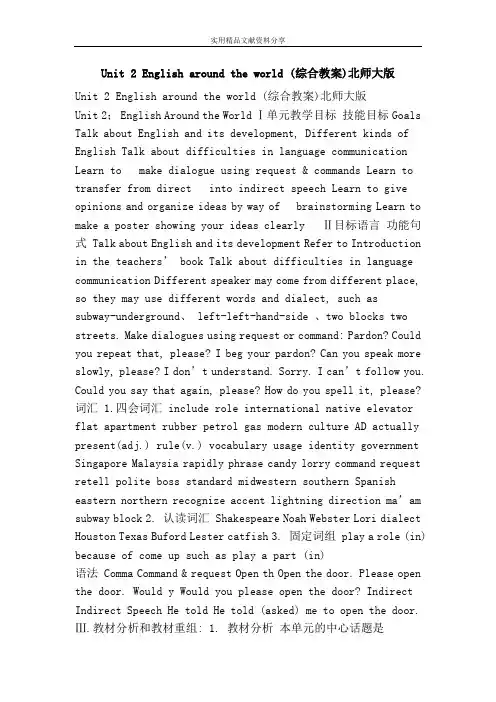
Unit 2 English around the world (综合教案)北师大版Unit 2 English around the world (综合教案)北师大版Unit 2;English Around the World Ⅰ单元教学目标技能目标Goals目标语言功能句式 Talk about English and its development Refer to Introduction in the teachers’ book Talk about difficulties in language communication Different speaker may come from different place, so they may use different words and dialect, such assubway-underground、 left-left-hand-side 、two blocks two streets. Make dialogues using request or command: Pardon? Could you repeat that, please? I beg your pardon? Can you speak more slowly, please? I don’t understand. Sorry. I can’t follow you. Could you say that again, please? How do you spell it, please? 词汇 1.四会词汇 include role international native elevator flat apartment rubber petrol gas modern culture AD actually present(adj.) rule(v.) vocabulary usage identity government Singapore Malaysia rapidly phrase candy lorry command request retell polite boss standard midwestern southern Spanish eastern northern recognize accent lightning direction ma’am subway block 2. 认读词汇 Shakespeare Noah Webster Lori dialect Houston Texas Buford Lester catfish 3. 固定词组 play a role (in) because of come up such as play a part (in)语法 Comma Command & request Open th Open the door. Please open the door. Would y Would you please open the door? Indirect Indirect Speech He told He told (asked) me to open the door. Ⅲ.教材分析和教材重组: 1. 教材分析本单元的中心话题是“English language and its develop ment, different kinds of English”. 通过对世界英语这一话题的探讨,加强学生对英语语言的了解,对当代语言特别是英语发展趋势的了解.世界在发展,时代在前进,语言作为交流的工具,也随着时代的发展而变化.由于英语在世界上的广泛使用,它不断地吸收、交融、容纳、创新,这就形成了各种各样带有国家、民族、地区特色的英语. 没有人们认为的那种唯一的标准英语。
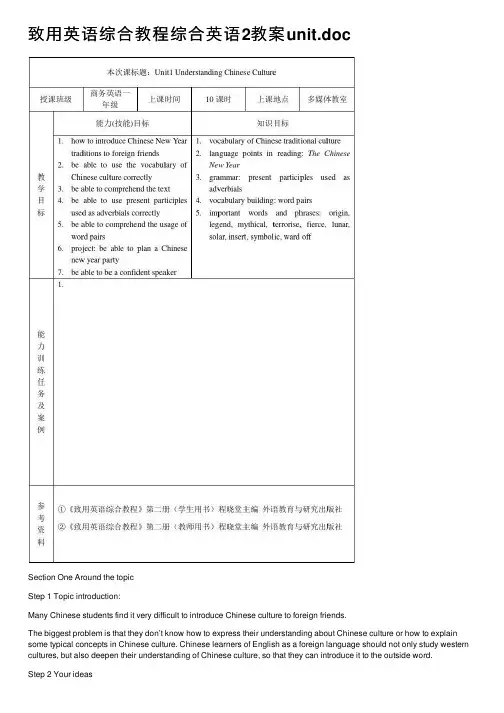
致⽤英语综合教程综合英语2教案unit.docSection One Around the topicStep 1 Topic introduction:Many Chinese students find it very difficult to introduce Chinese culture to foreign friends.The biggest problem is that they don’t know how to express their understanding about Chinese culture or how to explain some typical concepts in Chinese culture. Chinese learners of English as a foreign language should not only study western cultures, but also deepen their understanding of Chinese culture, so that they can introduce it to the outside word.Step 2 Your ideasWork in groups or pairs and discuss the following questions1)Why is spring Festival so important for the Chinese people?2)What do you usually do during the Spring Festival3)Are there any special celebration activities in your hometown during Spring Festival?4)In what ways do you think the Spring Festival has Changed?How much do you know about the Chinese New Year?A.Which day in the 15-day celebration is for the sons-in-laws to pay a visit to theirparents-in-law?The third and fourth days.B. What is the fifth day called?Po Woo.C. How many kinds of traditional New Year food do you know?Dumplings, a whole fish, chicken, New Year cake…D. Do we use knives or scissors on New Year's Day?NO. They may cut off fortune.E. What fruit do we usually use as a decoration during the Spring Festival?Oranges and Tangerines. They are symbols for abundant happiness.Step 3 VocabularyThere are some special things about Spring Festival, which are difficult to translate into English. Here are some English words and expressions related to the Spring Festival. Try to get their meanings.Remind students that names of some typical Chinese things do not have exact equivalents in English. Ask them to guess the meaning of the English words and phrases related to theThe teacher can offer students a particular situation for students to practice in which students can give a brief talk with some of the words in the table above so that they can master a better usage of these words.Step 4 Listening and speakingAsk students to read the questions first. Then play the recording and encourage them to take notes while listening.1.Q: What are they talking about?A: They are talking about the Spring Festival.2.Q: How did Li Ming spend his holiday?A: Li Ming spent his holiday with his family in his hometown.3.Q: What is Susan curious about?A: Susan is curious about how Chinese people celebrating their Spring Festival.4.Q: What make the Spring Festival different from other holidays?A: Giving presents and staying with the family.5.Q: What do Chinese People do on the Eve of the Spring Festival according to the recording?A: In the past, all the members of a family would stay at home making dumplings together.Now many people enjoy watching TV. During the day, children wear their new clothes. The evening is usually spent playing games, talking, eating and drinking.Step 5 A quizDuring the Spring Festival, some things are believed to bring good luck for the new year, while other things might bring bad luck. Read the items in the table below and decide whether they bring good luck or bad luck. When you finish, compare your answers in pairs.This quiz is just for fun. Remind students that we should not be superstitious and the dos and don’ts during the Spring Festival are only parts of our traditions and customs. We should hold a right attitude towards them.Ask students to do the exercise first based on their own understanding and then compare their answers with their partners’. They may discuss them if necessary. When they finish, you may show and explain answers.Section Two ReadingThis section introduces the tradition of the Chinese New Year. By studying it, students will learn more about the legend of Nian and traditional Chinese New Year celebration activities. Most importantly, students will learn how to introduce the Chinese New Year to foreign friends.Step 1 Pre-reading tasksBefore you read, discuss the following questions in groups:1.Do you know why we call the Spring Festival “Nian”?2.Do you know why we Chinese celebrate the New Year at a different time from the Westernworld?Read the instruction as a class. Divide students into groups. Ask them to discuss the questions. Activate their prior knowledge of the Spring Festival and encourage them to share informationwith others. Pick some volunteers to answer these tow questions as representatives of their group. Step 2 Text illumination 1)Ask several students to read the whole text in order to check whether they preview thetext and get a general understanding bout it or not beforehand.2)Ask students to summarize the text3)The teacher can put the comprehension check either before or after illuminating the textaccording to the needs of class and the students’ comprehension ability.4)Illuminate the text, during the process of which the teacher can encourage students tohighlight or underline the important parts when they read the text in detail. Try to explain that it can help students to grasp theimportant details and review important points Language points:1. legend n.story handed down from the past, especially one that may not be true 传奇,传说e.g. The legend of Robin Hood is well-known.2. mythical adj. existing only in an ancient story, imagined or invented 神话的,虚构的e.g. Qi Lin is a mythical Chinese creature which is similar to a unicorn.myth n. 神话e.g. ancient Greek myths3. terrorise v. to fill or overpower with terror, to terrify 使惊恐不安,恐吓e.g. The local gangs terrorised the neighborhood.4. fierce adj. violent and angry 凶猛的,凶狠的e.g. Swans are always fierce in defense of their young.The leopard looks fierce.5. lunar adj. determined or measured in reference to the moon 根据⽉亮决定或测定的e.g. The Chinese New Year falls on lunar January, 1st.6. solar adj. determined or measured in reference to the sun 根据太阳决定或测定的e.g. Solar energy is one kind of important energy nowadays.7. insert v. to put or set into, between, or among 插⼊,嵌⼊e.g. The editor inserted an advertisement in the newspaper.insert a key into a lock8. symbolic adj. representing a particular idea or quality 象征的,符号的e.g. The cross is symbolic of Christianity9. ward off to keep away (somebody/something that is dangerous or unpleasant) 挡开,避开e.g. He carried a gun to ward off possible attacks.Step 3 Post-reading exercises1.What is the significance of the following things during the Spring Festival?2.Discussion:Read the instruction as a class. Divide students into groups of four. Ask them to discuss these questions. Get feedback when they finish. Try to encourage them to express their opinions thoroughly in English.3.V ocabulary and structureThis part is about some vocabulary and structure exercises related to the text. Ask students to finish them independently beforehand. Check their answers in class. Try to encourage them to explain by themselves to check whether they fully understand the exercises or not. The teacher is supposed to give some explanations if necessary.A.Work out the meanings of the underlined words with the help of the context.B.Fill in the blanks with the words below. Change the form where necessary./doc/4b8dffd1f68a6529647d27284b73f242326c3101.html plete each pair of the sentences with the correct form of the same verb, one as apresent participle (-ing) and the other as a past participle (-ed).4.WritingRead the instruction as a class. Leave the writing task as homework. Check their work next time.Write down your experience about the Spring Festival. The following questions may help you to come up with some ideas.1)How does your family prepare for the Spring Festival?2)What traditional activities does your family do to celebrate the Spring Festival?3)What special activity do you like most when you are celebrating the Spring Festival?Section Three language in use: present participles used as adverbialsStep 1 test your grammarThe aim of this practice is to make students aware of the present participles used as adverbials. Based on their study of the text, they may gain a deeper understanding by doing these exercises. Try to encourage students to explain by themselves through recalling and understanding of this grammatical phenomenon.Step 2 illumination and developmentBriefly explain the grammatical knowledge of participles. Then ask students to finish these exercises. Check their work when they finish.⼀、现在分词做状语(表原因,时间,条件,让步,⾏为⽅式,伴随状况)现在分词与主句的主语⼀致,且形成主谓关系,就是说现在分词的动作发出者是主句的主语。
UNIT 1 NEVER SAY GOODBYE1. 他对这次面试中可能提到的问题作好了答案。
He has prepared answers to the questions that he expects to confront in the interview.2. 他悲惨的遭遇深深打动了我们,使我们几乎哭出声来。
His sad story touched us so deeply that we nearly cried.3. 他们俩手挽着手沿着河边散步,有说有笑。
They two are walking hand in hand along the river bank, chating and laughing happily.4. 听到这令人激动的消息之后,他眼睛里涌出欢乐的泪水。
When he heard the exciting news, tears of joy welled up in his eyes. 5. 上海人容易听懂苏州话,因为上海话和苏州话有许多共同之处。
People from Shanghai can understand Suzhou dialect easily, for Shanghai dialect and Suzho u dialect have much in common. 6. 亨利和妻子正在考虑能不能在3年内买一幢新房子。
Henry and his wife are looking into the possibility of buying a new house within 3 years.7. 女儿再三请求到国外去深造,他最终让步了。
He finally gave in to his daughter’s repeated request to further her education abroad.8. 我们在动身去度假前把所有的贵重物品都锁好了。
Unit 1We laughed into tears!Part1: 教材分析(Analysis of the teaching material)本课时系教材《英语 2 》(基础模块高教版)第一单元的第一部分,学生听一段关于和家人度假描述的对话。
训练学生在一定的语境下用合适的方式和语句组织关于描述假期活动的对话。
Part2: 教学目标(Teaching aims)Ss can understand expression of vacation description and make a dialogue discussing vacationLead-inAsk the students where did they go and what they did in the summer vacation and winter vacation. (Group discussion and then answer my questions)Step1:Lead students read the phrases and ask Ss to tick the activities they had taken part in.then check the answer.Step2:Teacher show the pictures for the Ss , explain the requests and then play the radio for theSs. Next, teacher asks some students to answer these questions.Listening & SpeakingPart1: 教材分析(Analysis of the teaching material)本课时系教材《英语 2 》(基础模块高教版)第一单元的听力及口语第一部分,学生听一段关于 Cindy 和家人度假描述的对话。
Lesson one: Fresh Start 教研室:专业英语 教师姓名:2012级基础英语教师
课程名称 综合教程3 授课专业及班次 12级英语 授课内容 Fresh Start 授课方式及学时 instruction and discussion 12 periods
目的要求 The usage and function of Nominal Clauses The main words and phrases in the text Oral Activities Writing
重点与难点 The usage and function of Nominal Clauses The main words and phrases in the text
讲授内容及 时间分配
Pre-reading Activities Global Reading: Structural Analysis and Rhetorical Features of the Text Detailed Reading: Class Activity, Words and Expressions, Sentences Consolidation Activities Oral Activities Writing extra-curricular material
教 具 Blackboard and Chalk Will Do!
参考资料 Information from the Internet; reference book of Contemporary College English; 1
Section One Pre-reading Activities Memorable Quotes Mistakes are the portals of discovery. — James Joyce
Experience is the name everyone gives to their mistakes. — Oscar Wilde James Joyce (1882-1941) was an Irish novelist and poet of the early 20th century, best known for his landmark novel Ulysses (1922), a modern re-telling of The Odyssey.
Oscar Wilde (1854-1900) was an Irish writer and poet, regarded as one of London‟s most popular playwrights in the early 1890s, also a spokesman for aestheticism.
Cultural Background 1. The importance of “face” “Face” is a sense of worth that comes from knowing one‟s status and reflects concern with the congruency between one‟s performance or appearance and one‟s real worth. “Face” stands for a very important sociological concept in Chinese culture. The concept of “face” roughly translates as honor, good reputation or respect. The essence of “face” lies in the drive for acceptance and approval of other people other than one‟s real worth.
2. Be yourself; everyone else is already taken. — Oscar Wilde Being yourself is celebrating you, as an individual — learning to express yourself and be happy with who you are. For some people, it‟s learning to love yourself. For others, it‟s not hiding who you are or changing things about you to fit in.
3. Steps to be yourself ● define yourself ● stop worrying about how people perceive you ● be honest and open ● relax ● develop and express your individuality ● believe in who you are ● follow your own style
Section Two Global Reading I. Structural Analysis of the Text This text is a piece of narrative writing, in which the author tells about her experience during 2
the first year at university, which at first seems to be very awkward but turns out to be on the right track at last.
In the text, three incidents are narrated by the author: the first is about her going into the wrong classroom; the second is about her falling down in the cafeteria; the last is about her witnessing the same embarrassing fall happening to someone admired by her.
Despite the differences between these three incidents, they actually revolve around one theme: The growth of the author, who is able to draw lessons from the mistakes she has made and finally succeeds in adjusting herself to the college life.
II. Rhetorical Features of the Text Detailed descriptions of events are everywhere to be seen in this text, which is a dominant feature of narrative writing. Since the description of an event will involve a lot of movements or actions, compound sentences and compound-complex sentences have been used frequently in the text.
For examples: I first began to wonder what I was doing on a college campus anyway when my parents drove off, leaving me standing pitifully in a parking lot, wanting nothing more than to find my way safely to my dorm room. (Paragraph 1) I settled into my chair and tried to assume the scientific pose of a biology major, bending slightly forward, tensing my arms in preparation for furious note-taking, and cursing under my breath. (Paragraph 5)
Rhetorical devices expressions of humor, exaggeration, and contrast: With the thought in mind, I raised my head,…(para.2, sentence 1) I spent the afternoon seeking out each room …perfectly timed entrance vs. wrong classroom (para.2, last sentence) As my rear end met the floor, I saw my entire life pass before my eyes (para.6, last sentence). I made my way through…tiptoed to a table…collapsed in relief. (para.9, first sentence)
Section Three Detailed Reading Questions 1. Why did the author have the impression that “everyone on campus was watching me”? Paragraph 1 The author, being over-sensitive, was uneasy with her identity as a freshman. She thought a new student would attract others‟ attention, as what she did or said was liable to be too naïve to be right. That feeling is a typical symptom of lacking in self-confidence.